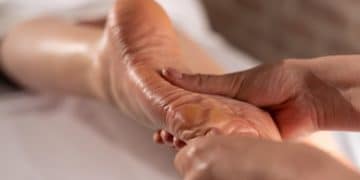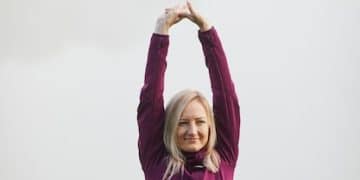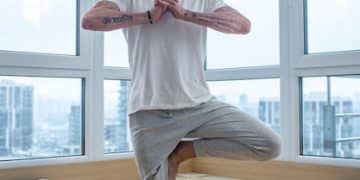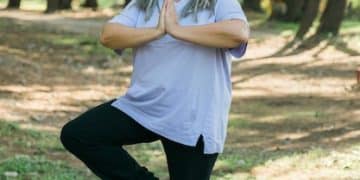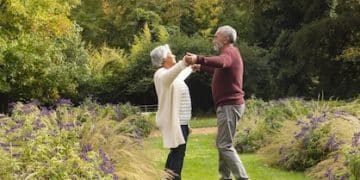Physical Therapy for Seniors with Arthritis: Key Benefits
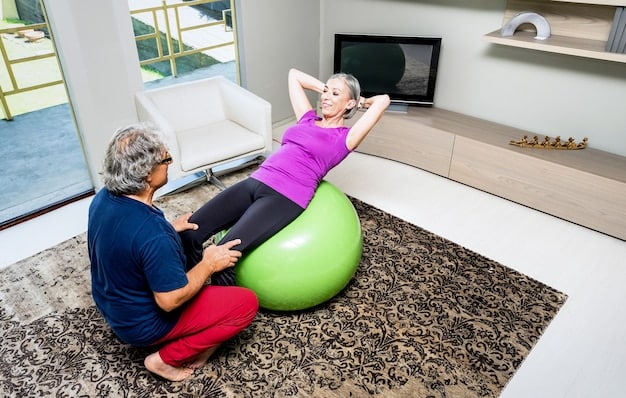
Regular physical therapy offers significant benefits for seniors with arthritis by reducing pain, improving mobility, and enhancing overall quality of life through tailored exercise and rehabilitative techniques.
Living with arthritis can present significant challenges, especially for seniors who often experience persistent pain, stiffness, and reduced mobility. However, there’s a powerful and often underutilized tool that can dramatically improve their daily lives: physical therapy. So, what are the benefits of regular physical therapy for seniors with arthritis? It’s a question that warrants a deep dive, as the answers reveal a pathway to improved well-being, greater independence, and a more active life.
Understanding Arthritis: A Senior’s Perspective
Arthritis is not a single disease but rather a general term for joint pain or joint disease. It encompasses over 100 different conditions, but the most common among seniors are osteoarthritis (OA) and rheumatoid arthritis (RA). Both can severely impact quality of life, leading to chronic pain, reduced joint function, and diminished independence. Age is a primary risk factor for OA, as years of wear and tear can degrade cartilage, while RA is an autoimmune disease that can affect individuals at any age but often manifests or worsens with time.
The progression of arthritis can vary widely among individuals. Some may experience mild discomfort, while others face debilitating pain and severe joint deformities. This variability underscores the importance of personalized care, and physical therapy stands out as a highly adaptable intervention. It addresses not just the symptoms but aims to restore function and prevent further deterioration. Ignoring the signs of arthritis or delaying intervention can lead to a vicious cycle where pain leads to inactivity, which in turn leads to greater stiffness and weakness, exacerbating the condition.
Types of Arthritis Affecting Seniors
Two main types of arthritis predominantly affect the senior population, each with distinct causes and progression patterns. Understanding these differences is crucial for effective treatment, including physical therapy.
- Osteoarthritis (OA): Often called “wear and tear” arthritis, OA is the most common form of arthritis among older adults. It occurs when the protective cartilage that cushions the ends of your bones wears down over time. This leads to bone rubbing on bone, causing pain, stiffness, and loss of movement. Factors contributing to OA include age, obesity, previous joint injuries, and genetics.
- Rheumatoid Arthritis (RA): RA is an autoimmune disease where the body’s immune system mistakenly attacks its own tissues, particularly the lining of the joints. This results in inflammation that can cause joint erosion and deformity. Unlike OA, RA can affect multiple joints simultaneously and may also impact other organs in the body.
While their origins differ, both OA and RA share common symptoms such as pain, stiffness, swelling, and reduced range of motion. These symptoms can make even simple daily tasks challenging, highlighting the critical role of interventions like physical therapy in managing the conditions.
Physical therapy provides a non-invasive, drug-free approach to managing arthritis symptoms and improving joint health. It focuses on movement, exercise, and education to help individuals reduce pain, increase mobility, and perform daily activities with greater ease. This foundational approach helps seniors maintain their independence and quality of life.
Reducing Pain and Inflammation
One of the immediate and most desired benefits of physical therapy for seniors with arthritis is significant pain reduction. Chronic pain can be debilitating, affecting mood, sleep, and overall engagement in life. Physical therapists employ various techniques to alleviate pain and reduce inflammation, which is a hallmark of arthritic conditions. These methods are often non-pharmacological, offering a safer alternative or complement to medication, especially for seniors who may be sensitive to drug side effects.
Therapists use a combination of manual therapy, personalized exercise prescriptions, and modalities like heat, cold, and electrical stimulation. Manual therapy involves hands-on techniques such as massage, mobilization, and manipulation to decrease pain, relax muscles, and improve joint alignment. These techniques can be particularly effective in breaking the pain-spasm cycle often seen in arthritic joints.
Targeting Pain with Therapeutic Modalities
Physical therapists are skilled in using various modalities to directly address pain and inflammation in arthritic joints. These tools can provide immediate relief, making it easier for seniors to participate in subsequent exercises.
- Heat Therapy: Applying heat helps relax tight muscles and increase blood flow to the affected area, reducing stiffness and pain. It can be used before exercise to warm up joints and make movement less painful.
- Cold Therapy: Ice packs or cryotherapy can help reduce inflammation and numb the area, providing acute pain relief, especially after activity or during flare-ups.
- Electrical Stimulation (e.g., TENS): Transcutaneous electrical nerve stimulation (TENS) units deliver low-voltage electrical currents to the skin, which can block pain signals to the brain and stimulate the release of endorphins, the body’s natural painkillers.
Beyond these immediate relief techniques, physical therapy also focuses on addressing the root causes of pain. This includes strengthening the muscles supporting the affected joints, improving flexibility, and correcting biomechanical imbalances that contribute to stress on the joints. By combining direct pain relief with long-term functional improvements, physical therapy provides a comprehensive strategy for managing arthritis pain.
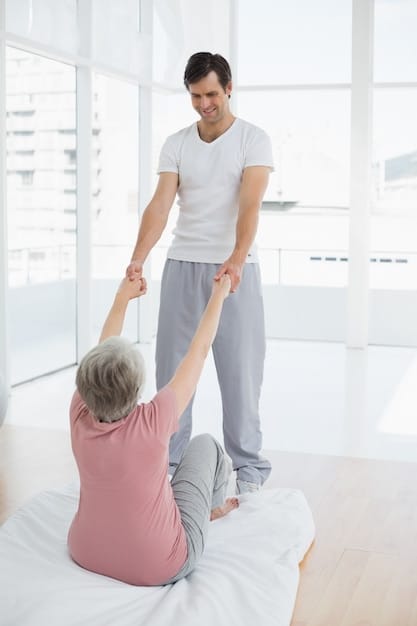
Moreover, the educational component of physical therapy teaches seniors how to manage their pain independently. This includes instruction on proper body mechanics during daily activities, posture correction, and self-management strategies for pain flare-ups. Empowering seniors with this knowledge fosters a sense of control over their condition, significantly improving their confidence and reducing the psychological burden of chronic pain.
Improving Mobility and Range of Motion
One of the most debilitating aspects of arthritis is the progressive loss of joint mobility and range of motion. Stiffness and limited movement restrict participation in daily activities, from simple tasks like dressing to more complex ones like walking or driving. Physical therapy is specifically designed to counteract this decline by implementing tailored exercises and techniques aimed at restoring and preserving joint function.
Range of motion exercises are fundamental in physical therapy programs for arthritis. These exercises gently move the joints through their full arcs, preventing stiffness and maintaining flexibility. Over time, consistent practice can expand the joint’s capacity for movement, making everyday activities easier and less painful. Therapists differentiate between active range of motion (where the patient moves the joint themselves) and passive range of motion (where the therapist moves the joint), adapting the approach to the patient’s specific needs and pain levels.
Tailored Exercise Programs
A key aspect of improving mobility is the development of individualized exercise programs. These programs are not one-size-fits-all but are meticulously crafted based on the senior’s specific type of arthritis, the affected joints, their current physical condition, and their personal goals. This personalization ensures that exercises are both effective and safe, minimizing the risk of aggravation or injury.
- Stretching Exercises: Focus on gently elongating muscles and connective tissues surrounding arthritic joints. Regular stretching can increase flexibility, reduce stiffness, and improve overall joint mobility.
- Strengthening Exercises: Target muscles that support the joints. Stronger muscles provide better stability and reduce the burden on worn-out cartilage, which in turn can lessen pain and improve function.
- Balance and Proprioception Exercises: Crucial for seniors, these exercises help improve coordination and balance, reducing the risk of falls, which can be particularly dangerous for individuals with compromised joint stability.
Beyond structured exercises, physical therapists also provide guidance on incorporating movement into daily life. This might include advice on safe walking techniques, ergonomic adjustments at home, or strategies for getting in and out of chairs or beds more easily. These practical tips empower seniors to maintain movement throughout their day, reinforcing the benefits gained during therapy sessions.
Ultimately, regular physical therapy’s emphasis on improving mobility and range of motion directly translates to a higher level of independence for seniors with arthritis. By enabling them to perform everyday tasks with less pain and greater ease, physical therapy helps them remain active participants in their own lives and communities.
Enhancing Strength and Stability
Arthritis not only causes pain and stiffness but also leads to muscle weakness and instability around the affected joints. This can create a vicious cycle where weak muscles offer less support, increasing stress on the joints, which in turn exacerbates arthritic symptoms. Physical therapy directly addresses this by focusing on enhancing strength and stability, crucial components for mitigating the progression of arthritis and preventing further injury.
Strength training in physical therapy is carefully designed to build muscle without putting undue stress on the joints. Therapists utilize various techniques, from bodyweight exercises to resistance bands or light weights, all tailored to the individual’s current strength and pain tolerance. The goal is to strengthen the muscles that surround and support the arthritic joints, providing a natural protective buffer and improving joint alignment.
Building Muscular Support
Muscular strength directly impacts joint stability. When muscles are weak, joints are more susceptible to movement in directions that can cause pain or further damage. Physical therapy aims to create a robust muscular corset around vulnerable joints.
- Isometric Exercises: These exercises involve contracting muscles without moving the joint, which is ideal for early stages or during flare-ups where joint movement is painful. They help maintain muscle mass and strength without stressing the joint.
- Progressive Resistance Exercises: As tolerated, therapists introduce exercises that involve movement against resistance. This could be lifting light weights, using resistance bands, or performing functional movements like rising from a chair or climbing stairs, gradually increasing intensity to build strength over time.
Improved muscular strength translates into better control over joint movement, reduced pain during activity, and a greater ability to perform daily tasks. For instance, stronger quadriceps muscles can significantly reduce knee pain in individuals with knee osteoarthritis by providing better shock absorption and stability during walking.
Beyond muscle strength, physical therapy also focuses on improving core stability and overall balance. A strong core provides a stable foundation for all movements, reducing strain on peripheral joints. Balance exercises help seniors maintain upright posture and reduce the risk of falls, a significant concern for those with compromised mobility. By addressing both strength and stability, physical therapy equips seniors with the physical resilience needed to cope with arthritis and maintain an active lifestyle.
Improving Balance and Preventing Falls
Falls are a major concern for seniors, and the risk is significantly higher for those living with arthritis due to pain, stiffness, muscle weakness, and impaired proprioception (the body’s sense of its position in space). A fall can lead to severe injuries, prolonged recovery, and a substantial loss of independence. Physical therapy plays a pivotal role in mitigating this risk by directly addressing the underlying physical factors that contribute to instability.
Balance training is a core component of physical therapy for arthritic seniors. Therapists introduce a series of exercises that challenge the balance system in a safe and controlled environment. These exercises gradually progress in difficulty, from standing on one leg to walking heel-to-toe or performing movements on unstable surfaces. The aim is to enhance coordination, improve reaction time, and strengthen the muscles essential for maintaining equilibrium.
Strategies for Enhanced Stability
Physical therapy programs incorporate various techniques to systematically improve balance and reduce fall risk, focusing on functional activities that mimic real-life movements.
- Proprioception Exercises: These exercises help retrain the body’s awareness of joint position. Activities that involve tactile feedback, like walking on different surfaces or standing with eyes closed, can sharpen this sense, improving overall stability.
- Dynamic Balance Training: Involves performing movements while maintaining balance, such as walking while turning the head or stepping over obstacles. This prepares seniors for managing unexpected challenges in their environment.
- Strengthening Lower Extremity Muscles: Strong leg and core muscles are fundamental for balance. Targeted exercises for the hips, thighs, and ankles provide the necessary power and control to prevent stumbles and correct imbalances.

In addition to exercise, physical therapists also provide practical advice on fall prevention within the home environment. This includes recommendations for removing tripping hazards, installing grab bars, ensuring adequate lighting, and wearing appropriate footwear. This holistic approach empowers seniors to not only improve their physical capabilities but also to create a safer living space.
The cumulative effect of improved balance, enhanced strength, and a safer environment significantly reduces the likelihood of falls. For seniors with arthritis, this means greater confidence in their movement, increased participation in social activities, and ultimately, a more independent and secure lifestyle. The peace of mind that comes from reduced fall risk is invaluable, contributing greatly to overall well-being.
Delaying or Avoiding Surgery
For many seniors facing advanced arthritis, surgery, such as joint replacement, often appears to be the only viable solution. While surgery can be highly effective, it comes with significant risks, a lengthy recovery period, and substantial costs. Regular physical therapy offers a powerful non-surgical alternative or complementary treatment that can significantly delay the need for surgery, or in some cases, help seniors avoid it altogether.
Physical therapy works by optimizing joint function through non-invasive means. By strengthening supporting muscles, improving range of motion, reducing pain, and enhancing stability, therapy aims to make the affected joint more functional and less painful, often to a degree that surgical intervention is no longer immediately necessary. This is particularly true for conditions like osteoarthritis, where conservative management is often the first line of treatment.
Comprehensive Conservative Management
The structured approach of physical therapy provides a robust framework for managing arthritis symptoms without resorting to surgical procedures. This involves a sustained commitment to therapeutic exercises and adherence to professional guidance.
- Functional Improvement: By focusing on daily activities, physical therapy aims to make tasks like walking, climbing stairs, or reaching overhead less painful and more efficient, thereby improving overall quality of life without the invasiveness of surgery.
- Pain and Symptom Management: Through various modalities and exercise, physical therapy effectively manages pain and inflammation, reducing the need for pain medications and allowing individuals to cope better with their condition without surgical intervention.
- Education and Self-Management: Therapists educate seniors on body mechanics, joint protection techniques, and appropriate activity levels. This knowledge empowers them to manage their condition proactively, potentially slowing joint degeneration and avoiding surgical triggers.
Even when surgery becomes inevitable, pre-operative physical therapy (prehab) can significantly improve surgical outcomes and shorten recovery times. By strengthening muscles and improving mobility before the procedure, patients are better prepared for the demands of post-operative rehabilitation. This proactive approach underscores the versatile benefits of physical therapy at various stages of arthritis management.
Choosing physical therapy as a primary or supplementary treatment allows seniors to maintain their natural joint structures for as long as possible, avoiding the potential complications associated with surgery. It empowers them with self-management tools and a healthier, more active lifestyle, potentially pushing back the need for invasive procedures for years, or even indefinitely. This emphasis on preserving natural function makes physical therapy an invaluable component of long-term arthritis care.
Enhancing Overall Quality of Life
Beyond the tangible physical improvements, one of the most profound benefits of regular physical therapy for seniors with arthritis is the significant enhancement in their overall quality of life. Chronic pain and limited mobility can erode an individual’s independence, lead to social isolation, and trigger emotional distress. Physical therapy addresses these broader impacts by restoring function, fostering confidence, and enabling participation in valued activities.
When seniors experience less pain and greater ease of movement, they are more likely to engage in social activities, hobbies, and family gatherings. This increased participation combats feelings of loneliness and depression, common among those with chronic conditions. The ability to perform daily tasks independently—like gardening, going shopping, or playing with grandchildren—contributes immensely to a sense of self-worth and purpose.
Beyond Physical Benefits: The Holistic Impact
The impact of physical therapy extends far beyond the muscles and joints, fostering holistic well-being that touches every aspect of a senior’s life.
- Increased Independence: By improving strength, mobility, and balance, physical therapy helps seniors perform daily activities without assistance, maintaining their autonomy and reducing reliance on others.
- Pain Management and Mental Well-being: Effective pain reduction leads to better sleep, improved mood, and reduced anxiety and depression. When pain is controlled, seniors can focus on living rather than suffering.
- Social Engagement and Activity: With renewed physical capabilities, seniors are more inclined to participate in social events, community activities, and leisure pursuits they once enjoyed, preventing isolation and fostering a sense of belonging.
Physical therapists often also provide education on energy conservation techniques and adaptive strategies that allow seniors to manage their daily activities more efficiently. This can involve teaching them how to pace themselves, use assistive devices effectively, or modify tasks to reduce joint stress. Empowering seniors with these practical skills further contributes to their ability to live fuller, more active lives despite their arthritis.
In essence, physical therapy gives seniors with arthritis not just stronger bodies, but also stronger spirits. It’s an investment in their physical health that pays dividends in mental resilience, social connectedness, and the ability to enjoy their golden years with dignity and vitality. By restoring function and reducing limitations, physical therapy helps seniors reclaim their lives from the grip of arthritis, promoting truly enhanced overall quality of life.
Practical Steps to Begin Physical Therapy
Starting physical therapy for arthritis might seem daunting, but the process is generally straightforward and begins with an assessment by a qualified professional. For seniors, ensuring the therapy plan is tailored to their specific needs and limitations is paramount for both safety and effectiveness. Finding the right therapist and understanding the typical journey can help ease any apprehension.
The first step typically involves obtaining a referral from a primary care physician or a rheumatologist. While direct access to physical therapy is available in many states, a doctor’s referral ensures that the therapist has a comprehensive understanding of the patient’s medical history and current health status, including any surgical history or concomitant conditions.
Finding the Right Therapist and Starting Your Journey
Choosing a physical therapist with experience in treating geriatric patients with arthritis is crucial. This specialization ensures they understand the unique physiological challenges and emotional needs of older adults.
- Consultation: During the initial visit, the physical therapist will conduct a thorough assessment, including evaluating joint range of motion, muscle strength, balance, posture, and gait. They will also discuss your medical history, current pain levels, and personal goals.
- Personalized Plan: Based on the assessment, a personalized treatment plan will be developed. This plan will outline specific exercises, manual therapy techniques, pain management strategies, and educational components. It will also establish measurable goals and a timeline for achieving them.
- Consistency and Adherence: The success of physical therapy heavily relies on consistency. Regular attendance at therapy sessions, combined with diligent practice of home exercises, is essential for optimal outcomes. Therapists will provide clear instructions and support to ensure adherence.
It’s also important for seniors and their families to understand that physical therapy is not a quick fix. It typically requires a commitment over several weeks or months, with gradual progression. Open communication with the therapist about progress, challenges, and any changes in symptoms is vital to ensure the plan remains effective and adapts to evolving needs.
Embracing physical therapy empowers seniors with a proactive approach to managing their arthritis. It offers a structured path toward improved physical function, reduced pain, and a higher quality of life, allowing them to remain active and independent. The journey may require effort, but the long-term benefits for freedom of movement and overall well-being are immeasurable.
| Key Benefit | Brief Description |
|---|---|
| 💪 Pain Reduction | Alleviates chronic pain and inflammation in arthritic joints, improving comfort. |
| 🚶♂️ Improved Mobility | Increases joint range of motion and flexibility, easing daily activities. |
| ⚖️ Enhanced Balance | Strengthens stability and reduces fall risk, promoting safety and confidence. |
| ✨ Better Quality of Life | Boosts independence, social engagement, and overall well-being. |
Frequently Asked Questions
▼
The frequency of physical therapy sessions for seniors with arthritis varies based on their condition severity, type of arthritis, and individual response to treatment. Initially, sessions might be 2-3 times per week, gradually decreasing as the patient progresses and focuses more on home exercises. A therapist will tailor the frequency.
▼
Physical therapy aims to reduce pain, not cause it. While some discomfort or soreness might occur as muscles strengthen or joints gain flexibility, activities are managed to stay within comfortable limits. Therapists employ various techniques and adjust intensity to minimize pain, ensuring the process is tolerable and beneficial.
▼
No, physical therapy cannot cure arthritis, as it’s a chronic condition. However, it is highly effective in managing symptoms, improving joint function, reducing pain, and slowing disease progression. It helps seniors regain independence and maintain a better quality of life by optimizing their physical capabilities and teaching self-management skills.
▼
Common exercises include a combination of range-of-motion exercises to maintain joint flexibility, strengthening exercises to support joints, balance training to prevent falls, and aerobic exercises to improve endurance and overall health. Exercises are always modified to suit individual joint limitations and pain levels, focusing on gentle, controlled movements.
▼
The timeline for seeing benefits from physical therapy varies depending on the individual’s condition and adherence. Many seniors report noticeable improvements in pain and mobility within a few weeks of consistent therapy. Significant functional gains often develop over several months. Long-term adherence to home exercises ensures sustained benefits.
Conclusion
The journey through aging with arthritis doesn’t have to be defined by escalating pain and diminishing independence. As explored, the benefits of regular physical therapy for seniors with arthritis are multifaceted and profound, offering a beacon of hope and a pathway to a more fulfilling life. From the direct relief of pain and inflammation to the crucial improvements in mobility, strength, and balance, physical therapy empowers seniors to reclaim control over their bodies. It provides a robust, non-invasive approach that can delay or even circumvent the need for surgery, significantly enhancing overall quality of life by fostering greater independence and reducing the pervasive fear of falls. Embracing physical therapy means investing in a future where movement is less a source of dread and more a source of joy and freedom, allowing seniors to continue living vibrantly and actively engaging with the world around them.

